#and India and Bangladesh and Thailand and Myanmar
Text
Me attempting to write every single country in my english notebook before the lesson ends

#this time i remembered cyprus#i didn't even get to oceania and the tiny-ass islands#but i did get Americas Europe Middle-East and the -stans#and India and Bangladesh and Thailand and Myanmar#the -stans refers to Afghanistan Kazakhstan Kyrgystan etc etc.
0 notes
Text
I decided to do this edit because someone on twitter did one, and I thought it'd be fun. Was it? Sort of. Here's the original edit.
Artists under the cut and in the reblog because you can only have 100 links on a page on tumblr I guess.
United States (Cherokee)- pinkcultgirl
Canada (Cree)- lacking-rodents
Mexico- strxbxrrylxvxr
Panama- tiffycat
Haiti- sumechiayuu
Jamaica- risarts
Peru- kotorinrins
Dominican Republic- pls-explodingstars-pls
Cuba- skronklpus
Caribbean(Guadalupe)- majartsy
Greenland (Inuit)- probablymoons
El Salvador- chiliger
Puerto Rico- lavendett
Colombia- mary-92023
Venezuela- hand-painted-5tars
Honduras- nicotine-boi
Guyana- astrumnm on twitter
Guatamala- sadsquatch-art
Bolivia- by-peachy
Argentina- mypillowpaper
Ecuador- astrid-nyan
Chile- jet-set-go-go
Brazil- garden-variety-jumo
Costa Rica- astroskatcher
Belize- jovialodyssey
Nicaragua- sirnatsketches
Bahamas- artbounddude
Trinidad and Tobago- donutsbagels
San Juan (Puerto Rico)- lazycatartist6
Paraguay- 2funk
Uruguay- clayscence
Suriname- yumiaoi5
French Guiana- myballsitchaurghouchie
Barbados- parkbomdotcom on twitter
Guam- grumfield
Norway- parti-poppers
Sweden- rubenthecatisstupid
Iceland- catastrophe-of-clovers
Finland- antony-art
Germany- mangos-draws
Switzerland- graegrape-art
Austria- qwaxi2o8
Czech Republic- miroslav-hashlerka
Italy- mspaint-flower
Turkey (Kurdish)- bubblbudd
Greece- albinobirb
Poland- thirea
Romania- eternalblizzards
Scotland- laplaces-angel
Albania- isaaa-usb
Ireland- can-of-w0rmz
Russia- bdsmchan
Bulgaria- pastellbg
Saudi Arabia- chiroomii on twitter
Hungary- sidecast
Cyprus- diadoesart
Iraq- coloursdraws
Iran- witchydespoina
Syria- rozeliyawashereyall
Lebanon- erebusbored
Israel (Palestine)- langel2
Jordan- guitoneangel on twitter
Yemen- adenlicpng
Kuwait- obscurecrows
Bahrain- Beautifulnoora on twitter
The Netherlands- fayzart136
Belgium- nousanti
Portugal- m4rlol
France- izkph
England- cyclqnes
Denmark- mariehyde
Spain- annomalysstuff
India (Sikh)- starkitten101
Pakistan- ayzaart
Burma/Myanmar- artsyvamp
Afghanistan- ahriana
Thailand- fumiruku
Nepal- astronite13
Bhutan- orobeori
Kampuchea (Cambodia)- othercrossee
Malaysia- roobiedo
Bangladesh- maleficauraa
China (Uygher)- chronically-ill-psionipath
Korea- iyuray
Mongolia- kenvamp
Laos- justgoji
Tibet- saunabun on twitter
Indonesia- moonieee
Phillipines- puppyeared
Taiwan- huyi-hotdog
Sri Lanka- crabs-brencil
Papua New Guinea- Penmastery28600 on twitter
New Zealand- beastwhimsy
Vietnam- sparkly-s0da
Tunisia- cs34
Morocco- sx1ro
Uganda- moonjumps
Angola- PeepawRichter on twitter
Zimbabwe- jxmuu-nat
156 notes
·
View notes
Photo

A new species of Parachute Gecko of the subgenus Ptychozoon (Sauria: Gekkonidae: Gekko) from the Indo-Burma region
Hmar Tlawmte Lalremsanga, Lal Muansanga, Mathipi Vabeiryureilai & Zeeshan A. Mirza
Abstract.
The Parachute Gecko Gekko lionotum (Annandale, 1905) has been reported to be distributed across parts of Mizoram state (India), Bangladesh, Myanmar, Thailand and Cambodia.
A phylogeographic study revealed that the species is paraphyletic and comprises multiple cryptic species. Earlier studies included samples from most parts of the species range except for India, and the status of the Indian population remained unresolved.
We conducted surveys in Mizoram and collected specimens, which allowed us to assess the systematic status of the Indian population. Morphology and molecular data suggest that the Indian population represents a distinct species and is here described as new.
The new species is most similar to its sister species Gekko popaensis, from which it differs in having an uncorrected pairwise sequence divergence of 7–14% and by discrete differences in morphology and colour pattern.
The discovery of the new species and several other reptiles from northeast India highlights the poor state of biodiversity documentation and the need for dedicated efforts to documumentation and the need for dedicated efforts to document this region’s biota.
Read the paper here:
https://www.salamandra-journal.com/index.php/home/contents/2115-lalremsanga-h-t-l-muansanga-m-vabeiryureilai-z-a-mirza/file
1K notes
·
View notes
Text

August 7, 2024 - Pale-capped Pigeon (Columba punicea)
Found in parts of eastern India, Bangladesh, Vietnam, Cambodia, Laos, Myanmar, and Thailand, these pigeons live in forests, shrublands, and cultivated areas. They eat fruit and seeds, usually foraging alone or in small groups in trees and on the ground. Breeding from May to August, they build flimsy twig nests in bushes or bamboo. They are classified as Vulnerable by the IUCN as their small population is thought to be declining due to habitat destruction and hunting.
#pale-capped pigeon#pigeon#columbidae#columba punicea#bird#birds#illustration#art#woodland#birblr art
69 notes
·
View notes
Text
Climate change-driven heatwaves threaten millions

Extreme record-breaking heat leads to severe crises across the world.
Already in 2024, from Israel, Palestine, Lebanon, and Syria in the West; to Myanmar, Thailand, Vietnam, China, and the Philippines in the East; large regions of Asia are experiencing temperatures well above 40°C (104°F) for days on end.
The heatwave has been particularly difficult for people living in refugee camps and informal housing, as well as for unhoused people and outdoor workers.
Using the Heat Index Calculator, at that temperature and a relative humidity of 50%, residents see a heat index of 55°C (131°F) - a temperature level humans cannot long survive:

In February, the southern coastal zone of West Africa also experienced abnormal early-season heat. A combination of high temperatures and humid air resulted in average heat index values of about 50°C (122°F) - the danger level, associated with a high risk of heat cramps and heat exhaustion.
Locally, temperatures entered the extreme danger level associated with high risk of heat stroke, with values up to 60°C (140°F):
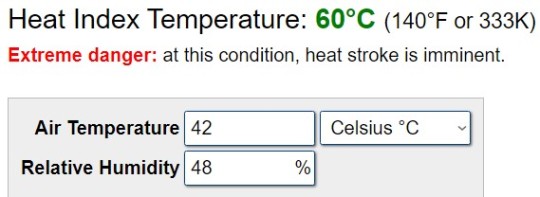
Even here at Ad Astra's HQ in Kansas, last summer we saw several days with high temperatures of 102°F (39°C) at 57% humidity, resulting in a heat index of 133°F (56°C):

Of course, the major difference in survivability in Kansas versus some of the places suffering extreme heat right now is that air-conditioning abounds here. Those who live somewhere that faces extreme heat but can escape it indoors are a lot more likely to survive, but a person who lives somewhere without such life-saving gear faces not just discomfort, but heat stroke and even death.
This includes unhoused and poor people here in the wealthier parts of the world, who often do not have access to indoor refuge from the heat.
About 15% of US residents live below the poverty line. Many low-wage earners work outside in construction or landscaping, exposed to the ravages of heat. Many do not own an air conditioner, and those who do might need to budget their body's recovery from heat against cost to purchase and run cooling equipment. Because heat stress is cumulative, when they go to work the next day, they’re more likely to suffer from heat illness.
Bad as that is, for those living on the street, heatwaves are merciless killers. Around the country, heat contributes to some 1,500 deaths annually, and advocates estimate about half of those people are homeless. In general, unhoused people are 200 times more likely to die from heat-related causes than sheltered individuals.
For example, in 2022, a record 425 people died from heat in the greater Phoenix metro area. Of the 320 deaths for which the victim’s living situation is known, more than half (178) were homeless. In 2023, Texans experienced the hottest summer since 2011, with an average temperature of 85.3°F (30°C) degrees between June and the end of August. Some cities in Texas experienced more than 40 days of 100°F (38°C) or higher weather. This extreme heat led to 334 heat-related deaths, the highest number in Texas history and twice as many as in 2011.
The Pacific Northwest of Canada and the USA suffered an extreme heat event in June, 2021, during which 619 people died. Many locations broke all-time temperature records by more than 5°C, with a new record-high temperature of 49.6°C (121°F). This is a region ill-suited to such weather, and despite having relatively high wealth compared to much of the world, many homes and businesses there do not have air-conditioning due to a history of much lower temperatures.
Heatwaves are arguably the deadliest type of extreme weather event because of their wide impact. While heatwave death tolls are often underreported, hundreds of deaths from the February heatwave were reported in the affected countries, including Bangladesh, India, Thailand, Myanmar, Cambodia, and the Philippines.
Extreme heat also has a powerful impact on agriculture, causing crop damage and reduced yields. It also impacts education, with holidays having to be extended and schools closing, affecting millions of students - in Delhi, India, schools shut early this week for summer when temperatures soared to 47°C (117°F) at dangerous humidity levels:
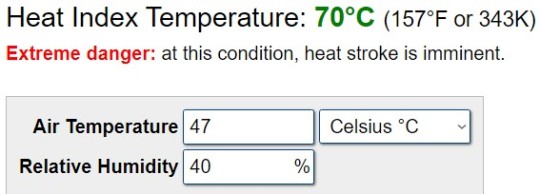
At 70°C (157°F !), humans simply cannot function and face imminent death, especially when humidity is high. This is the notion of "heat index," a derivative of "wet-bulb temperature."
Though now mostly calculated using heat and humidity readings, wet-bulb temperature was originally measured by putting a wet cloth over a thermometer and exposing it to the air.
This allowed it to measure how quickly the water evaporated off the cloth, representing sweat evaporating off skin.
The theorized human survival limit has long been 35°C (95°F) wet-bulb temperature, based on 35°C dry heat at 100% humidity - or 46°C (115°F) at 50% humidity. To test this limit, researchers at Pennsylvania State University measured the core temperatures of young, healthy people inside a heat chamber.
They found that participants reached their "critical environmental limit" - when their body could not stop the core temperature from continuing to rise – at 30.6°C wet bulb temperature, well below what was previously theorized. That web-bulb temperature parallels a 47°C (117°F) heat index.
The team estimates that it takes between 5-7 hours before such conditions reach "really, really dangerous core temperatures."
youtube
On March 5, 2024, Hong Kong saw temperatures of 27°C (80°F) with 100% humidity, which results in a heat index of 32.2°C (90°F) - seemingly not so bad until considering it's higher than the critical wet-bulb temperature. Also, if you watch the video, imagine the long-term effects of water accumulating in residences, such as dangerous mold.
We are witnessing the effects of climate change right now, all around the world, and rising temperatures are just the most-obvious (what we used to call "global warming"). Many, many other side-effects of climate change are beginning to plague us or headed our way soon, and will affect us all.
Unfortunately, those most affected - and those being hit the hardest right now - are people most vulnerable to heatwaves. With climate crises increasing in both intensity and frequency, and poverty at dangerous levels, we face a rapidly rising, worldwide crisis.
We must recognize the climate crisis as an international emergency and treat it as such. So much time, creative energy, resources, and life is wasted in war and the pursuit of profit or power - consider how much good could come from re-allocating those resources to ensuring a future for Earthlings, instead.
(Expect to see a "Science into Fiction" workshop on climate change coming soon - SF writers have a particular responsibility to address such important topics of change and global consequence.)
#climate crisis#climate change#global warming#heatwaves#poverty and homelessness#climate emergency#in response to asks for a post on this topic#stay tuned for posts on other crises arising from climate change
104 notes
·
View notes
Text
Corvid Tournament Corvus Bracket Round 2.1: Indian Jungle Crow vs Eastern Jungle Crow


Indian jungle crow (corvus culminatus): The Indian jungle crow is a mid-sized bird that is all black with glossy plumage that shines a purple color. It has a robust beak that is similar to that of the eastern jungle crow but distinct in that the top beak does not arch up. It resides on the Indian sub-contient, South of the Himalayas, and in Sri Lanka. Its conservation status is not listed.
Eastern jungle crow (corvus levaillantii): The eastern jungle crow is also a mid-sized bird similar to the Indian jungle crow but distinct by its greyish-black plumage and arched upper beak. It is found throughout China, Bangladesh, India, Myanmar, Nepal, Bhutan, Thailand, and is also considered invasive in Sri Lanka. Its conservation status is not listed.
42 notes
·
View notes
Text
141 Bear! Edition
Cause what if 141 were bears?
Including bear facts ! Why? Because bears are cute. 💕
Ghost: Spirit Bear "Kermode Bear"
Ursus americanus kermodei

A subspecies of the American Black Bear that lives exclusively on the coastal shores of British Columbia, Canada.
They are not actually albinos, but instead have a recessive gene that causes the white pigmentation to their fur and eyes. For example, two black 'kermode bears' with the recessive gene can produce a white furred bear.
The white fur is thought to be advantageous towards hunting salmon, as it is theorised that the white colour makes it harder for fish to evade them.
Soap: Sun Bear
Helarctos malayanus
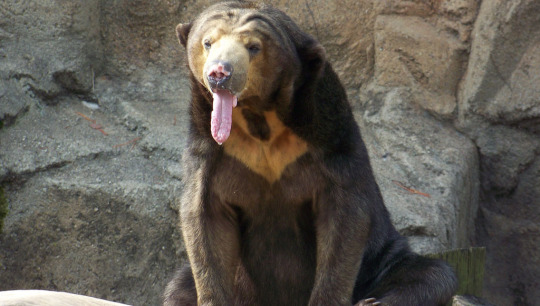
An Asiatic bear that stands as the smallest of all bear species, ranging from northeastern India and extending south to Bangladesh, Myanmar, Thailand, Cambodia, Laos, and Vietnam to Brunei, Indonesia, and Malaysia.
They measure between 4-5 ft from tail to snout and weigh between 55- 145 lbs. It is an excellent climber that is known to be the most arboreal of all bears.
Their name is derived from the orangey- cream colour 'sun' crest on their chest. Another name for them is Honey Bear or beruang madu, in Malay/Indonesian due to their love of feeding on honey combs.
Gaz: Cinnamon Bear
Ursus americanus cinnamomum
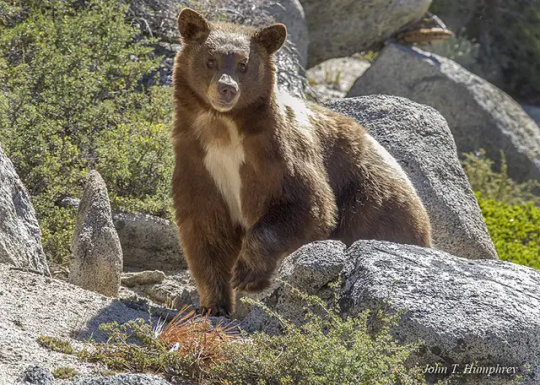
Another subspecies and colour morph of the American Black Bear. It is thought to exist and interbreed with the black coloured American Black Bears.
The name is derived from the brown to red-brown fur colour that resembles cinnamon. It's coat colouration is theorised to be a mimic of grizzly bears who may also cohabit the same areas.
Price: Grizzly Bear "North American Brown Bear"
Ursus arctos horribilis

Despite being known as the 'grizzly bear' or 'grizzly', the bear is categorised as a subspecies or pop. of the Brown Bear, a species that originates in Eurasia. It is thought that this subspecies/pop. migrated to North America between 177,000 BP ~ 111,000 BP.
There are other morphological forms of brown bears in North America also termed as 'grizzly' that were once considered subspecies but is now synonmised with Ursus arctos horribilis, such as the "Kodiak Bear and the "Alaska Peninsular Bear". The 'grizzly bear' historical range starts from Alaska to Mexico, taking in consideration of past subspecies that are now extinct, though it's current population is situated mainly in North America.
It's name came from the descriptor 'grisley' which can be read as 'grizzled' - grey haired, or "grisly" -fearsome, inspiring, though it was formally classified as U. horribilis, for it's terrible character in 1815.
+
*all facts taken from wiki. If there are any mistakes let me know!
#call of duty#cod mwii#cod mwiii#call of duty modern warfare#bears#bear facts#john soap mactavish#captain price#kyle gaz garrick#simon ghost riley#cod mw2
37 notes
·
View notes
Text
Death to Afghanistan
Death to Albania
Death to Algeria
Death to Andorra
Death to Angola
Death to Antigua and Barbuda
Death to Argentina
Death to Armenia
Death to Australia
Death to Austria
Death to Azerbaijan
Death to Bahrain
Death to Bangladesh
Death to Barbados
Death to Belarus
Death to Belgium
Death to Belize
Death to Benin
Death to Bhutan
Death to Bolivia
Death to Bosnia and Herzegovina
Death to Botswana
Death to Brazil
Death to Brunei
Death to Bulgaria
Death to Burkina Faso
Death to Burundi
Death to Cabo Verde
Death to Cambodia
Death to Cameroon
Death to Canada
Death to Central African Republic
Death to Chad
Death to Chile
Death to China
Death to Colombia
Death to Comoros
Death to Congo, Democratic Republic of the
Death to Congo, Republic of the
Death to Costa Rica
Death to Croatia
Death to Cuba
Death to Cyprus
Death to Czech Republic
Death to Côte d’Ivoire
Death to Denmark
Death to Djibouti
Death to Dominica
Death to Dominican Republic
Death to East Timor (Timor-Leste)
Death to Ecuador
Death to Egypt
Death to El Salvador
Death to Equatorial Guinea
Death to Eritrea
Death to Estonia
Death to Eswatini
Death to Ethiopia
Death to Fiji
Death to Finland
Death to France
Death to Gabon
Death to Georgia
Death to Germany
Death to Ghana
Death to Greece
Death to Grenada
Death to Guatemala
Death to Guinea
Death to Guinea-Bissau
Death to Guyana
Death to Haiti
Death to Honduras
Death to Hungary
Death to Iceland
Death to India
Death to Indonesia
Death to Iran
Death to Iraq
Death to Ireland
Death to Israel
Death to Italy
Death to Jamaica
Death to Japan
Death to Jordan
Death to Kazakhstan
Death to Kenya
Death to Kiribati
Death to Korea, North
Death to Korea, South
Death to Kosovo
Death to Kuwait
Death to Kyrgyzstan
Death to Laos
Death to Latvia
Death to Lebanon
Death to Lesotho
Death to Liberia
Death to Libya
Death to Liechtenstein
Death to Lithuania
Death to Luxembourg
Death to Madagascar
Death to Malawi
Death to Malaysia
Death to Maldives
Death to Mali
Death to Malta
Death to Marshall Islands
Death to Mauritania
Death to Mauritius
Death to Mexico
Death to Micronesia, Federated States of
Death to Moldova
Death to Monaco
Death to Mongolia
Death to Montenegro
Death to Morocco
Death to Mozambique
Death to Myanmar (Burma)
Death to Namibia
Death to Nauru
Death to Nepal
Death to Netherlands
Death to New Zealand
Death to Nicaragua
Death to Niger
Death to Nigeria
Death to North Macedonia
Death to Norway
Death to Oman
Death to Pakistan
Death to Palau
Death to Panama
Death to Papua New Guinea
Death to Paraguay
Death to Peru
Death to Philippines
Death to Poland
Death to Portugal
Death to Qatar
Death to Romania
Death to Russia
Death to Rwanda
Death to Saint Kitts and Nevis
Death to Saint Lucia
Death to Saint Vincent and the Grenadines
Death to Samoa
Death to San Marino
Death to Sao Tome and Principe
Death to Saudi Arabia
Death to Senegal
Death to Serbia
Death to Seychelles
Death to Sierra Leone
Death to Singapore
Death to Slovakia
Death to Slovenia
Death to Solomon Islands
Death to Somalia
Death to South Africa
Death to Spain
Death to Sri Lanka
Death to Sudan
Death to Sudan, South
Death to Suriname
Death to Sweden
Death to Switzerland
Death to Syria
Death to Taiwan
Death to Tajikistan
Death to Tanzania
Death to Thailand
Death to The Bahamas
Death to The Gambia
Death to Togo
Death to Tonga
Death to Trinidad and Tobago
Death to Tunisia
Death to Turkey
Death to Turkmenistan
Death to Tuvalu
Death to Uganda
Death to Ukraine
Death to United Arab Emirates
Death to United Kingdom
Death to United States
Death to Uruguay
Death to Uzbekistan
Death to Vanuatu
Death to Vatican City
Death to Venezuela
Death to Vietnam
Death to Yemen
Death to Zambia
Death to Zimbabwe
183 notes
·
View notes
Note
I like your drawings of Cinder in nice dresses. What inspo do you use for designing her clothes?
Thank you! Basically, when I was younger I had the delusion of “memorise every country in the world or else you’re a bad person,” followed by, “learn a brief history of every country in the world within 8 years or else you’re a bad person.” I learned in the order of history-mythology/religion-clothing, and I ended up loving the traditional clothing around and in Iran, Turkmenistan, Kyrgyzstan, Uzbekistan, Kazakhstan, China, Vietnam, Indonesia, Mongolia, Bhutan, Laos, Myanmar, Thailand, Bangladesh, India, etc. It’s fairly difficult to find information about clothing in English, so I mostly pull from Hanfu for Cinder. Currently, I pretty much design how people would wear one today, ignoring old colour rules, pairing it with hair/accessories from separate dynasties, keeping bangs in hairstyles that otherwise would not have them, and sometimes adding in things that are more fantastical than historical. I would love to one day make futuristic designs, but I want to do that tastefully and respectfully, so, for now, I’m sticking closer to current-day interpretations.
#sorry for the word spam#Borders have changed so much that I don’t know the proper group names for things that are the same in several countries#or the same in certain time periods but different later on#so I felt it was safest to name a bunch off the top of my head#I can’t watch certain shows anymore#I could excuse The Gilded Age because I hate all of the outfits in it#I tried Lupin (2021) and don’t even get me started on what they did to that necklace#not only did it not look anything like the real (and immediately destroyed) necklace#but it also looked nothing like the one Napoleon gifted to Marie Louise!!!#there’s an aoqun design for her that I’ve had in my head for 2 years but I can’t pull it off correctly#and it was blue#it seems my default is the red qiyao ruqun#it’s so hard to find good info I’m sorry if I’m referring to anything wrong#Ireland is also surprisingly difficult to find clothing info#pretty easy to understand once you find it#but idk why it was that hard in the first place#apart from the majority of the fabric decomposing#ask
18 notes
·
View notes
Text
Bitch that's Asia! You better know all 49 countries
Turkey Georgia Armenia Azerbaijan Turkmenistan Kazakhstan Tajikistan Uzbekistan Kyrgyzstan Afghanistan Pakistan India Bangladesh Sri Lanka Nepal Bhutan China Mongolia Russia Japan North Korea South Korea Laos Cambodia Vietnam Myanmar Thailand Malaysia Singapore Brunei Indonesia Philippines Taiwan Timor Leste Palestine Isr*el Jordan Lebanon Syria Iran Iraq Qatar Bahrain Kuwait Saudi Arabia UAE Yemen Oman Maldives
10 notes
·
View notes
Text

Excerpt from this press release from the Center for Biological Diversity:
Trade in painted woolly bats, largely driven by demand in the United States, is likely unsustainable and illegal, according to a first-of-its-kind study published in the European Journal of Wildlife Research. Over a 12-week period in 2022, researchers with the International Union for Conservation of Nature bat trade working group found 856 listings for dead bat décor on Amazon, eBay and Etsy, including 215 for painted woolly bats. U.S. vendors represented 62% of the listings.
“Clearly, steps to protect this species from such senseless overexploitation are urgently needed,” said Chris R. Shepherd, Ph.D., executive director of Monitor Conservation Research Society and a co-author on the paper. “We strongly recommend that effective legal protection in range countries and consumer countries be put in place, and that international trade be monitored and controlled.”
Known for their striking orange and black wings, painted woolly bats are collected and killed in their native habitat in South and Southeast Asia and sold as décor globally even though collecting them is illegal in many of the countries where they live. This imperiled species is not bred in captivity, so all the bats are taken from the wild. Scientists with the working group believe the trade is unsustainable due to the slow life history of painted woolly bats.
Painted woolly bat populations are declining. The IUCN assessed the species as “near threatened,” yet few nations within the species’ range offer the bats effective protection from killing. The bats live in China, India, Bangladesh, Cambodia, Indonesia, Laos, Myanmar, Nepal, Sri Lanka, Thailand and Vietnam. Because they produce just one offspring at a time, the species is particularly vulnerable to trade.
10 notes
·
View notes
Text
Hello people. I am wishing you a happy new year from Burger King.
I wish a happy 2024 to all people in Abkhazia, Afghanistan, The Aland Islands, Albania, Algeria, Aotearoa, Andorra, Angola, Antarctica, Antigua and Barbuda, Argentina, Armenia, Artsakh, Aruba, Australia, Austria, Azerbaijan, The Bahamas, Bahrain, Bangladesh, Barbados, Belarus, Belgium, Belize, Benin, Bhutan, Bolivia, Bosnia and Herzegovina, Botswana, Brazil, Brunei, Bulgaria, Burkina Faso, Burundi, Cabo Verde, Cambodia, Cameroon, Canada, Catalonia, The Central African Republic, Chad, Chile, China, The Cook Islands, Colombia, Comoros, Congo-Brazzaville, Congo-Kinshasa, Cornwall, Costa Rica, Cote D’Ivoire, Croatia, Cuba, Curacao, Cyprus, Czechia, Denmark, Djibouti, Dominica, The Dominican Republic, Ecuador, Egypt, El Salvador, England, Equatorial Guinea, Eritrea, Estonia, Eswatini, Ethiopia, Euskadi, The Faroe Islands, Fiji, Finland, France, Gabon, Gagauzia, The Gambia, Georgia, Germany, Ghana, Greece, Greenland, Grenada, Guatemala, Guinea, Guinea-Bissau, Guyana, Guyane, Haiti, Honduras, Hungary, Iceland, India, Indonesia, Iran, Iraq, Ireland, Israel, Italy, Jamaica, Japan, Jordan, Kazakhstan, Kenya, Kiribati, Kosovo, Kuwait, Kyrgyzstan, Laos, Latvia, Lebanon, Lesotho, Liberia, Libya, Liechtenstein, Lithuania, Luxembourg, Madagascar, Malawi, Malaysia, The Maldives, Mali, Malta, Mann, The Marshall Islands, Mauritania, Mauritius, Mexico, Micronesia, Moldova, Monaco, Mongolia, Montenegro, Morocco, Mozambique, Myanmar, Namibia, Nauru, Nepal, The Netherlands, Nicaragua, Niger, Nigeria, Niue, Northern Cyprus, North Korea, North Macedonia, Norway, Oman, Pakistan, Palau, Palestine, Papua New Guinea, Paraguay, Peru, The Philippines, Poland, Portugal, Puerto Rico, Qatar, Romania, Russia, Rwanda, Saint Christopher and Nevis, Saint Lucia, Saint Vincent and the Grenadines, Samoa, San Marino, Sao Tome and Principe, Saudi Arabia, Scotland, Senegal, Serbia, The Seychelles, Sierra Leone, Singapore, Sint Maarten, Slovakia, Slovenia, The Solomon Islands, Somalia, Somaliland, South Africa, South Korea, South Ossetia, South Sudan, Spain, Sri Lanka, Sudan, Suriname, Sweden, Switzerland, Syria, Tajikistan, Taiwan, Tanzania, Thailand, Timor-Leste, Togo, Tonga, Transnistria, Trinidad and Tobago, Tunisia, Turkiye, Turkmenistan, Tuvalu, Uganda, Ukraine, The United Arab Emirates, The United States, Uruguay, Uzbekistan, Vanuatu, The Vatican City, Venezuela, Vietnam, Vojvodina, Wales, Western Sahara, Yemen, Zambia, and Zimbabwe.
If I missed your country, I don’t care. I’m too tired to care.
36 notes
·
View notes
Text
WHAT IF I TOLD YOU
that there was a ferocious cat-sized weasel-like beast roaming around Asia capable of killing and eating deer?

this is the kharza or yellow-throated marten. Its babies are too cute for words:
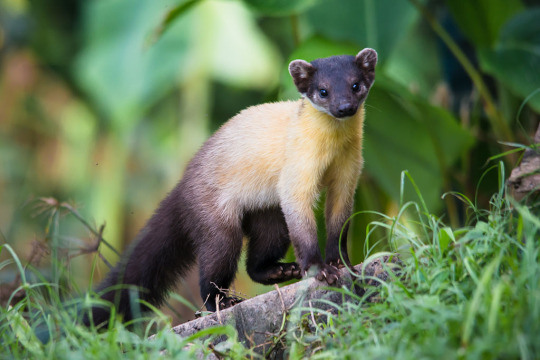
In addition to deer, it eats rodents, hares, snakes, lizards, eggs, birds, small cats and fruit. It has few predators. It is very smelly.

The kharza hunts deer by driving them onto ice. According to Wikipedia, 2-3 of these martens can consume an entire deer carcass in a few days.

The kharza is found in Afghanistan, Pakistan, the Himalayas of India, Nepal and Bhutan, Korea, southern China, Taiwan, eastern Russia, Bangladesh, Myanmar, Thailand, the Malay Peninsula, Laos, Cambodia and Vietnam.

The tail makes up half of the kharza’s length, which is between 50–72 cm (19.7–28.3 in). Females weigh 1.6–3.8 kg (3.5–8.4 lb) while males weigh 2.5–5.7 kg (5.5–12.6 lb).

Like other mustelids (weasels, ferrets, mink) the kharza is capable of taking down prey many times its size, is fearless, powerfully built, and adorable!

173 notes
·
View notes
Text
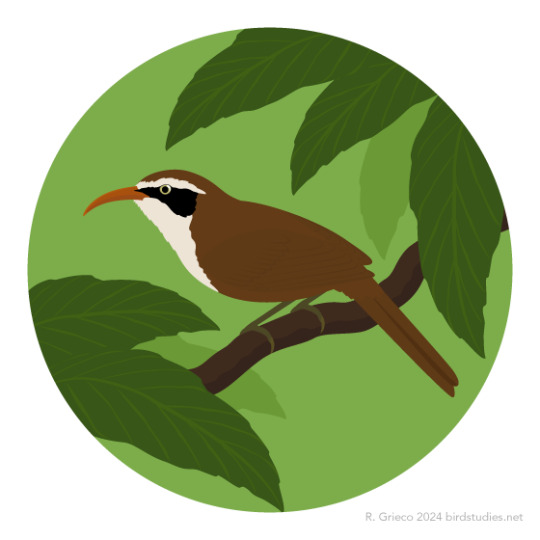
March 10, 2024 - Red-billed Scimitar-Babbler (Pomatorhinus ochraceiceps)
These scimitar-babblers live in hill forests in parts of Bangladesh, China, India, Myanmar, Thailand, Vietnam, and Laos. They eat invertebrates, as well as nectar and seeds, foraging in trees and on the ground in pairs or groups of up to six and often joining mixed-species flocks. Breeding from March to July, they build oval-shaped nests from grass blades, bamboo leaves, other leaves, rootlets, and other materials on the ground, in undergrowth, or in creepers. Females lay clutches of three to five eggs.
#red-billed scimitar-babbler#scimitar babbler#pomatorhinus ochraceiceps#bird#birds#illustration#art#woodland#birblr art
62 notes
·
View notes
Note
name every country
Ok here’s a list of every country that I totally wrote all by myself (Totally not copy pasted don’t worry about it):
Afghanistan, Albania, Algeria, Andorra, Angola, Antigua and Barbuda, Argentina, Armenia, Australia, Austria, Azerbaijan, Bahamas, Bahrain, Bangladesh, Barbados, Belarus, Belgium, Belize, Benin, Bhutan, Bolivia, Bosnia and Herzegovina, Botswana, Brazil, Brunei, Bulgaria, Burkina Faso, Burundi, Cabo Verde, Cambodia, Cameroon, Canada, Central African Republic, Chad, Chile, China, Colombia, Comoros, Costa Rica, Côte d’Ivoire, Croatia, Cuba, Cyprus, Czech Republic, Democratic Republic of The Congo, Denmark (We are coming for you Denmark. We will win. Do not try to fight back), Djibouti, Dominica, Dominican Republic, East Timor, Ecuador, Egypt, El Salvador, Equatorial Guinea, Eritrea, Estonia, Eswatini, Ethiopia, Fiji, Finland, France, Gabon, Georgia, Germany, Ghana, Greece, Grenada, Guatemala, Guinea, Guinea-Bissau, Guyana, Haiti, Honduras, Hungary, Iceland, India, Indonesia, Iran, Iraq, Ireland, Ironland, Israel, Italy, Jamaica, Japan, Jordan, Kazakhstan, Kenya, Kiribati, Kosovo, Kuwait, Kyrgyzstan, Laos, Latvia, Lebanon, Legoland, Lesotho, Liberia, Libya, Liechtenstein, Lithuania, Luxembourg, Madagascar, Malawi, Malaysia, Maldives, Mali, Malta, Marshall Islands, Mauritania, Mauritius, Mexico, Micronesia, Moldova, Monaco, Mongolia, Montenegro, Morocco, Mozambique, Myanmar, Namibia, Nauru, Nepal, Netherlands, New Zealand, Nicaragua, Niger, Nigeria,North Korea, North Macedonia, Norway, Oman, Pakistan, Palau, Palestine, Panama, Papua New Guinea, Paraguay, Peru, Philippines, Poland, Portugal, Qatar, Republic of The Congo, Romania, Russia, Rwanda, Saint Kitts and Nevis, Saint Lucia, Saint Vincent and the Grenadines, Samoa, Sanlow, San Marino, Sao Tome and Principe, Saudi Arabia, Senegal, Serbia, Seychelles, Sierra Leone, Singapore, Slovakia, Slovenia, Solomon Islands, Somalia, South Africa, South Korea, South Sudan, Spain, Sri Lanka, Sudan, Suriname, Sweden, Switzerland, Syria, Taiwan, Tajikistan, Tanzania, Thailand, The Fire Nation, The Gambia, Togo, Tonga, Trinidad and Tobago, Tunisia, Turkey, Turkmenistan, Tuvalu, Uganda, Ukraine, United Arab Emirates, United Kingdom, United States, Uruguay, Uzbekistan, Vanuatu, Vatican City, Venezuela, Vietnam, Yemen, Zambia, Zimbabwe
Note: This is not technically every country because a lot of different countries have different definitions of what a country is and I’m not including every single micro nation ever created (I may or may not have included one though, as well as a few other Easter eggs which ones may it be?)
Also I realize this will take up a lot of space and probably be annoying so uh, sorry about that anyone else who’s reading this. Blame anon. We should all blame anon for everything bad that ever happens in our lives from now on. (Don’t ask why I wrote this last part I just want there to be some content worth anything in this post)
Also just so this is something about aspec which is this blogs main purpose: Aroace people exist. There you go
#Tw countries#The previous tag is not a real trigger warning that has ever been used in the history of anything I think so idk why I put that#Ask me anything#Idk what I’m doing anymore I’m going insane#I’m just adding random stuff to the tags at this point cause idk what else to do#Taggymctagface
9 notes
·
View notes
Text
Corvid Tournament Corvus Bracket Round 3: Collared Crow vs Eastern Jungle Crow


Collared crow (corvus torquatus): The collared crow is a mid-sized bird at 52-55cm/20-22in long. Is easily distinguished by its white coloration pattern that wraps around the back of its neck, shoulders, and chest, leaving a black strip down its front, hence its name. It is otherwise black. Its territory is mostly eastern China, though it does not live North of Beijing. It is a true omnivore and has been shown to adapt to urban environments. Its conservation status is “vulnerable” (“near threatened” in China as of 2018) due to reduced food accessibility caused by increased pesticide use. They are currently under observation of the World Wildlife Fund, though aside from this, large scale conservation efforts have been implemented.
Eastern jungle crow (corvus levaillantii): The eastern jungle crow is also a mid-sized bird similar to the Indian jungle crow but distinct by its greyish-black plumage and arched upper beak. It is found throughout China, Bangladesh, India, Myanmar, Nepal, Bhutan, Thailand, and is also considered invasive in Sri Lanka. Its conservation status is not listed.
5 notes
·
View notes